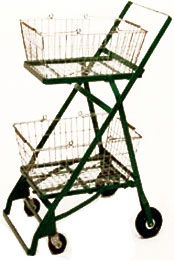Grocery shopping is one of those chores that we all have to do from time to time. I’m introducing the topic of grocery shopping as a service journey not because the concept is new. In-store ethnographic studies, and shop-alongs, implicitly recognize the concept. Few people who analyze what grocers do, and how people who shop in their stores get the job of buying groceries done, would be surprised that it is a journey. And, of course, the journey starts in the shopper’s home, which Tesco’s Fresh and Easy discovered the hard way when they expanded from the United Kingdom to the United States. What I want to do here is provide a brief, high level history of the U.S. grocery shopper’s journey, and key transformations of that journey, to establish the context for my next post.
Other than time, money, and typically transportation, two pieces of technology are critical to the journey we take as we shop, especially for groceries. We must collect items around the store and move them to the checkout counter. Once our grocery items are checked out and we pay for them, we must move those groceries from the store to our source of transportation. For many of us that transportation consists of an automobile, or other vehicle; for others it may be public transport.
A partial solution to the challenge of collecting items around the store came with the invention of flat-bottomed paper bags by Margaret Knight in 1870. However, it really wasn’t until Walter  H. Deubner, a grocery store owner in St. Paul, Minnesota, created a shopping bag in 1915 (a paper bag with a cord running through it for strength) that a workable solution to the challenge of collecting and moving items from shelves to the checkout counter came along. The Deubner Shopping Bag carried up to seventy pounds of groceries. In other words, at least initially, the grocery bag was supplied before customers began to shop.
H. Deubner, a grocery store owner in St. Paul, Minnesota, created a shopping bag in 1915 (a paper bag with a cord running through it for strength) that a workable solution to the challenge of collecting and moving items from shelves to the checkout counter came along. The Deubner Shopping Bag carried up to seventy pounds of groceries. In other words, at least initially, the grocery bag was supplied before customers began to shop.
 The invention of the shopping cart by Sylvan Goldman in 1936 provided the basis for changing the shopping journey. Consider the problems he faced in persuading shoppers to change their shopping journey.
The invention of the shopping cart by Sylvan Goldman in 1936 provided the basis for changing the shopping journey. Consider the problems he faced in persuading shoppers to change their shopping journey.
Goldman’s concept was simple: make shopping easier for the customer and they’ll visit the store more frequently, and buy more. Unfortunately, the customers didn’t want to use the carts. Young men thought they would appear weak; young women felt the carts were unfashionable; and older people didn’t want to appear helpless. So, Goldman hired models of all ages and both sexes to push the things around the store, pretending they were shopping. That, and an attractive store greeter encouraging use of the carts, did the trick.
By 1940 shopping carts had found so firm a place in American life as to grace the cover of the Saturday Evening Post. Supermarkets were redesigned to accommodate them. Checkout counter design and the layout of aisles changed.
As a result, shopping bags were relocated in the shopper’s journey, with the exception of small bags for produce and other perishables. The invention of plastic bags later on added another alternative for bagging, in the produce section as well as the checkout counter, and it was a cheaper direct cost than paper.
Today, the result of these basic technologies for supporting grocery shoppers makes the experience much easier, no doubt less stressful on the back and shoulders than carrying heavy bags around the store while shopping. My next post focuses on the current transformational challenge facing the grocery shopper’s service journey through the diffusion of reusable bags.
Posted by Larry R. Irons
Share this post…














This cool post. I like it. Thanks for sharing article.
Thanks, if you liked this one you will love the next.
I can not believe the amount of excellent content which is available on this particular site. The website is quite attractive and drags people directly in, the articles are usually perfect quality and are extremely professionally written. I have seen too many of these sites where it seems as if they pay an 8 yr old to do the writing – Not this one. Yuor web blog is definitely the very best that i have looked at in a longer while.
Glad the content here strikes a chord. Hope you continue to read what I write.
I really like the theme on your blog, I run a WordPress website too, and I would really like to use this theme. Anyway you can tell me what its called?
It is the theme Contempt, though I changed the basic theme’s CSS for my own look and feel.
I have been browsing on-line more than three hours today, but I never found any fascinating article like yours. It is beautiful value enough for me. Personally, if all website owners and bloggers made just right content as you did, the net will be a lot more helpful than ever before.
I’m glad you appreciate the time and attention to detail I try to include in each post. Thanks!